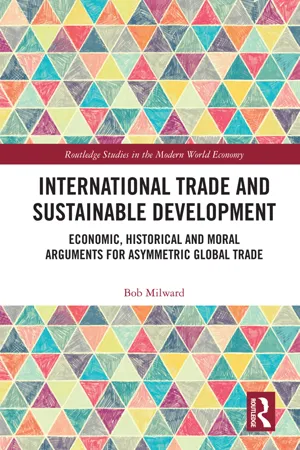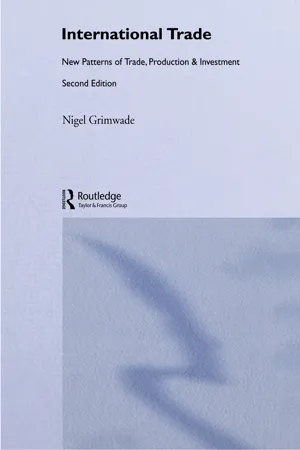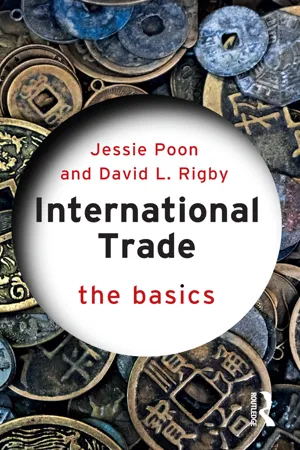Comparative Advantage
Comparative advantage refers to a country's ability to produce goods or services at a lower opportunity cost than another country. This concept is based on the idea that countries should specialize in producing goods or services in which they have a comparative advantage, and then trade with other countries to obtain goods and services in which they have a comparative disadvantage.
7 Key excerpts on "Comparative Advantage"
- eBook - ePub
International Trade and Sustainable Development
Economic, Historical and Moral Arguments for Asymmetric Global Trade
- Bob Milward(Author)
- 2019(Publication Date)
- Routledge(Publisher)
...As such, policy prescriptions for trade follow the principles set out in the Comparative Advantage constructs and follow the adage of free trade as the most efficient way in which to conduct international trading relations. The law, or principle, of Comparative Advantage, holds that under a regime of free trade, an economic agent will produce more of and consume less of a good for which they have a Comparative Advantage. The concept of Comparative Advantage is the economic explanation of the gains from trade that accrue to individuals, firms or nations, and which arise from differences in their level of technology or their factor endowments. In the model, economic agents will have a Comparative Advantage over others in producing a particular good if they can produce that good at a lower relative opportunity cost or autarky price. In other words, if, prior to trade, they can produce the good at a lower relative marginal cost. Comparison should not be made in terms of the monetary costs of production or indeed, the resource costs in terms of the amount of labour required to produce a unit of output. Rather, it is the opportunity costs of producing goods across countries that should be compared in this model. In order to fully appreciate the nuances of the Ricardian construct, we need to recognise the motivations of David Ricardo’s writing of his Principles of Political Economy and Taxation (1817). Essentially, it was a treatise in favour of the abolition of the Corn Laws in Britain that were a protectionist device to keep out cheap wheat from abroad to maintain the profits of British farmers. Ricardo argued that this was to the detriment of British industrialists who had an inbuilt desire to accumulate out of their profits at a superior rate than the landlords. Therefore, the corn laws increased the price of food, which reduced the available demand for industrial goods (workers were spending more on food and had less remaining to buy the goods of the industrialists)...
- eBook - ePub
International Trade
New Patterns of Trade, Production and Investment
- Nigel Grimwade(Author)
- 2020(Publication Date)
- Routledge(Publisher)
...So long as each country possesses a Comparative Advantage in at least one activity, it pays to specialise in that activity and engage in trade. Differences in comparative costs are given by comparing the relative cost ratios existing in the two countries before trade. These express the cost of producing one unit of a particular good in terms of the number of units of the other good that must be forgone in order to do so. If we assume that all labour is employed in one or other activity, an extra unit of one good can only be produced by reducing output of the other. This way of expressing cost is what economists call 'opportunity cost' or the cost of something expressed in terms of opportunities foregone. We can see this by considering an example of two countries similar to that used to illustrate the principle of absolute advantage. Once again, each country is considered to have the same labour resources and to divide these equally between two activities. Cloth Wheat 000s 000s Country A 100 200 Country B 80 100 Total 180 300 In this case. Country A is more efficient at both activities. If, however, we measure the opportunity cost of producing each product in both countries, it will be apparent that A has a Comparative Advantage in wheat and B has a Comparative Advantage in cloth. In A, the production of an extra unit of wheat requires sacrificing 0.5 units of cloth, whereas in B, it requires sacrificing 0.8 units of cloth. Thus, A has a Comparative Advantage in wheat production. Turning next to cloth, the cost of producing an extra unit of cloth in A is 2 units of wheat and in B 1.25 units of wheat. So, B has a Comparative Advantage in cloth production. Note also that these pre-trade cost ratios for each country will give the pre-trade relative price ratios. Now, let us see what happens if both countries specialise in the product in which they enjoy a Comparative Advantage...
- eBook - ePub
- John Weiss(Author)
- 2010(Publication Date)
- Routledge(Publisher)
...Hence, it is not manufacturing per se that is important, but within manufacturing the goods that a country can produce relatively efficiently and thus export successfully to the rest of the world. There are different explanations for Comparative Advantage differences between countries corresponding to different theories of trade. Cost differences can arise though differential access to technology (Ricardian models), different resource endowments (Heckscher-Ohlin models) or increasing returns to scale (New Trade Theory models). However, regardless of the origin of cost differences, the idea that specialisation should be where comparative costs are lowest has had a key influence on policy across most countries in recent decades. The case has both static and dynamic dimensions. In static terms, assuming a perfectly competitive two commodity framework, with full employment and diminishing returns to scale, it can be shown that trade without restriction (free trade) leads the economy to a higher level of welfare than does no trade (autarky). With diminishing returns the maximum output of each commodity (a and b) with a given level of resources is shown as a bowed out curve QQ1 in Figure 3.1 (the production possibility frontier). At any point the slope of QQ1 shows the amount of one commodity sacrificed for additional production of the other (the opportunity cost). Thus, the opportunity cost of a unit of a is the loss of b as a result of the diversion of resources to the production of a. Extending beyond a simple two commodity framework a country can be said to have a Comparative Advantage in goods in which its opportunity cost is lower than that in its trading partners. In Figure 3.1, without trade, efficiency in terms of maximising production and meeting consumer preferences, will be at point x where the line reflecting the relative domestic prices for a and b is at a tangent to QQ1...
- eBook - ePub
- W. Charles Sawyer, Richard L. Sprinkle(Authors)
- 2020(Publication Date)
- Routledge(Publisher)
...CHAPTER 3 Comparative Advantage and the production possibilities frontier Nature, by giving a diversity of geniuses, climates, and soils, to different nations, has secured their mutual intercourse and commerce as long as they all remain industrious and civilized. The industry of the nations, from whom they import, receives encouragement: Their own is also increased, by the sale of the commodities which they give in exchange. David Hume INTRODUCTION I n the previous chapter, we considered a number of aspects of international trade. We first showed that international trade occurs for the same reason that domestic trade occurs. Next we considered trade as a way for businesses to make a profit and for consumers to obtain lower-priced goods. This initial look at international trade showed that trade is driven by the existence of different prices for goods in different countries. The analysis to this point left one important question unanswered: why are the prices different? To answer this question, we first considered the theory of trade based on absolute advantage. Some countries can produce goods at a lower price because labor in that country is more productive in producing that particular good. Trade based on absolute advantage is deficient in some respects as a complete explanation of trade. To remedy these problems, we then considered the theory of Comparative Advantage. Countries have a Comparative Advantage in the production of goods where the opportunity cost of producing those goods is low. While the theory of Comparative Advantage is quite general, our discussion of the reasons for international trade is not complete. Specifically, we made an assumption in Chapter 2 that is not always realistic. In our previous analysis, we assumed constant costs. This is not an unreasonable assumption in many cases. However, you may recall from Principles of Economics that there are other cost conditions...
- eBook - ePub
- Enrico Colombatto(Author)
- 2016(Publication Date)
- Routledge(Publisher)
...This example reproduces the essence of the theory of Comparative Advantage – or, more appropriately, comparative cost – which is in fact a version of the opportunity-costs reasoning we already detailed in Chapter 1. In the simplest terms, the theory of comparative costs maintains that it pays for Alicia to specialise and sell good X in exchange for good Y, as long as Alicia needs to devote fewer resources to producing X and then trading it for Y, rather than producing Y at home. In particular, it does not matter whether Alicia is better than her counterpart Bob at producing both X and Y. The important point is that Alicia's productivity lead is proportionately greater in X, and Bob's lag is proportionately smaller in Y. In this way, Alicia will not waste energies/resources in producing Y (where her cost advantage is smaller), and Bob will not waste energies/resources in producing X (where his cost disadvantage is larger). Of course, the fact that Alicia is more efficient than Bob is not without consequences, because it means that Alicia will not have to work very hard to produce the quantity of X she needs for her own consumption and to buy Y, and the opposite will be true for Bob. In other words, the fact that Alicia is more competitive (i.e. more efficient) in the production of both X and Y means that she enjoys higher living standards, and that these standards are going to be higher, the greater the possibility of specialising in the industries in which her production costs are lower relative to those of Bob. Certainly, the theory of comparative cost is persuasive when one has in mind natural-resource endowments, and it rationalises one's intuitive explanation of why Saudi Arabia specialises in oil extraction and production, while agricultural goods and processed food figure prominently – for example – in Argentinean exports. Yet, nowadays food, agricultural products and fuels account for about one-third of world trade...
- eBook - ePub
International Trade
The Basics
- Jessie Poon, David L. Rigby(Authors)
- 2017(Publication Date)
- Routledge(Publisher)
...Comparative Advantage establishes that free trade will generate gains for trading partners if each of them specializes in producing the commodity where they hold the greatest Comparative Advantage, the commodity where their opportunity costs are minimized. The H–O model explains how the gains from trade are distributed in a world with two countries, two goods and two inputs to production. The H–O model states that gains from trade will be realized when countries specialize in the production of those commodities that use their abundant factors of production intensively. Within this framework, the owners of the factor of production that is abundant within a country gain from trade while the owners of the scarce factor of production lose as a result of trade. Models of monopolistic competition explain why countries that produce the same commodities engage in trade. New models of global outsourcing help us understand the fragmentation of production tasks and the distribution of those tasks across countries within the global economy that are endowed with different types of factors of production. Suggested Reading A gentle introduction to Comparative Advantage is provided by the Economist. See Schools Brief: The Miracle of Trade. The Economist, 27 January 1996. The World Trade Organization provides a relatively recent overview of trade theory and data. WTO (2008) World Trade Report 2008: Trade in a Globalizing World (available at www.wto.org/english/res_e/booksp_e/anrep_e/world_trade_report08_e.pdf) The United Nations Conference on Trade and Development (UNCTAD) has many Resources on globalization, trade and development. Check out http://unctad.org Resources The SUNY Levin Institute has an excellent introduction to many aspects of globalization, including trade...
- eBook - ePub
The Theory of International Business
Economic Models and Methods
- Mark Casson(Author)
- 2016(Publication Date)
- Palgrave Macmillan(Publisher)
...It is a simple application of the principle of opportunity cost. It implies that products should be produced by individuals who have the lowest opportunity cost for that product in terms of the amount of other products that they could have produced instead. Comparative Advantage also has a simple mathematical expression. Recall that worker 1 can produce either b 01 units of product 0 or b 11 units of product 1, and worker 2 can produce either b 02 units of product 0 or b 12 units of product 1. Worker 1 has Comparative Advantage in product 0 if b 01 / b 11 > b 02 / b 12, and Comparative Advantage in product 2 if the inequality is reversed, b 01 / b 11 < b 02 / b 12. If a worker is comparatively advantaged in one product then they are comparatively disadvantaged in the other. Comparative Advantage is equivalent to relative opportunity cost. Suppose that worker 1 produces product 1; then their opportunity cost of product 1 in terms of product 0 is c 1 = b 01 / b 11, as noted earlier. Similarly worker 2’s opportunity cost of product 1 is c 2 = b 02 / b 12. It is cheaper for worker 1 to produce product 1 if c 1 < c 2, which implies that b 01 / b 11 < b 02 / b 12, that is, worker 1 has Comparative Advantage in product 1. Conversely, it is cheaper for worker 2 to produce product 1 if c 1 > c 2, which implies that b 01 / b 11 > b 02 / b 12, that is, worker 2 has Comparative Advantage in product 1. A distinction is often drawn between Comparative Advantage and absolute advantage. If worker 2 is more productive than worker 1 in product 1 then they may be said to have an absolute advantage in product 1, and if they are more productive in product 2 they may be said to have an absolute advantage in product 2. If they have an absolute advantage in both it might be said that worker 1 has an absolute advantage over worker 2. As noted above, absolute advantage alone is not sufficient to determine who does what, but it does have implications for how much they earn from what they do...






